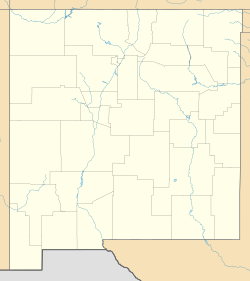Fort Fillmore facts for kids
|
Fort Fillmore
|
|
| Nearest city | Las Cruces, New Mexico |
|---|---|
| Area | 24.4 acres (9.9 ha) |
| Built | 1851 |
| NRHP reference No. | 74001196 |
Quick facts for kids Significant dates |
|
| Added to NRHP | July 30, 1974 |
Fort Fillmore was an important United States Army post built in September 1851. It was located near Mesilla, in what is now New Mexico. The main reason for building Fort Fillmore was to protect people traveling to California. These early travelers, often called frontier migrants, faced dangers from local Native American groups. The U.S. government built a network of forts to help protect these travelers and encourage people to move west. Fort Fillmore was placed in an area known for Apache attacks. This area was where several important travel routes met, connecting El Paso and Tucson.
Contents
Building Fort Fillmore: A Frontier Outpost
Fort Fillmore was first built using a style called jacal. This meant it had upright wooden posts covered with adobe plaster. Later, stronger adobe walls were added. Much of the building work was done by the soldiers themselves. Local Mexican workers also helped by making the adobe bricks.
The fort was built on sandy hills above the Rio Grande river. Over time, the Rio Grande changed its path. This left the fort about a mile away from the river. Because of this, the army had to use wagons to bring water to the fort. This also made it harder to defend the fort if it was attacked.
Who Served at Fort Fillmore?
Many different types of soldiers served at Fort Fillmore. These included units from the 1st Dragoons, the Regiment of Mounted Rifles, and the 3rd and 8th Infantry Regiments. For a while, it was even the main headquarters for the 3rd Infantry Regiment.
These soldiers were active in several missions. They took part in the Gila Expedition in 1857. They also fought against the Apaches in the Sacramento Mountains. During one mission, a brave officer named Captain Henry W. Stanton was killed. He is the person for whom Fort Stanton, New Mexico, is named. His grave was one of the few that could be found when the fort was checked in 1869. Most of the soldiers and civilians buried at the fort's cemetery are still there today. A fence and a flagpole now mark the cemetery site.
One of the most famous soldiers who served at Fort Fillmore was Captain George Pickett. He is best known for leading a famous charge during the Battle of Gettysburg in the American Civil War. Another important person, Union General Ambrose Burnside, used Fort Fillmore as a supply point in 1855. He was drilling for geothermal wells about fifteen miles west of the fort at that time.
Fort Fillmore During the Civil War
Fort Fillmore played a part in the American Civil War. On July 25, 1861, Union soldiers tried to attack Confederate soldiers near Mesilla. This event is known as the First Battle of Mesilla. The Union attack was not successful.
Two days later, the Union army decided to leave Fort Fillmore. They set the fort on fire before retreating towards Fort Stanton. The Union soldiers became very thirsty and tired during their retreat. When 300 Confederate soldiers approached the 500 retreating Union soldiers, the Union commander surrendered his troops without a fight.
Later, on August 7, 1862, federal troops fought a small battle near Fort Fillmore. They defeated Confederate troops who were retreating from Santa Fe.
The End of Fort Fillmore
The Union army officially closed Fort Fillmore in October 1862. However, the fort was still mentioned as a stopping point on several important travel routes for many years. Major routes like the Upper and Lower Emigrant Trails, the Butterfield Trail, and the Pacific and Overland Trails all passed through this area. Fort Fillmore was built to protect these very routes.
The remains of the fort were later leveled. This happened after the owner tried to sell or trade the land to the State of New Mexico to become a park, but it didn't work out. Today, a group of pecan trees stands where the fort once was.


